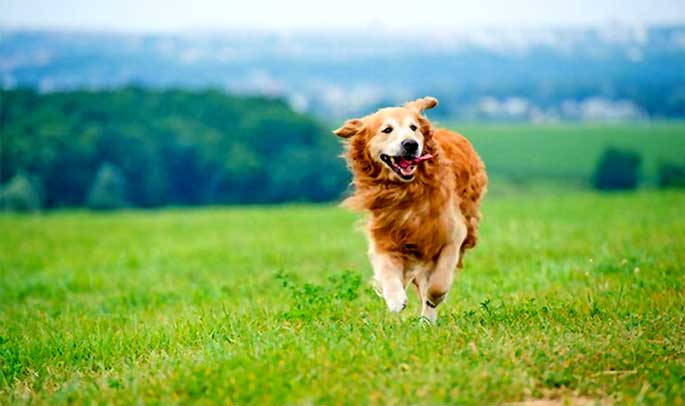
Maintaining the health of your dog’s hair and skin is an essential part of caring for your furry friend. While the amount of care will vary depending on hair length and breed, the process of brushing, bathing, and feeding is relatively similar across the board.

So if your dog is struggling with brittle hair, flaky skin, and a dull coat, it may be time to develop a more intensive care routine. With the following tips in mind, you’ll soon have a happy, healthy dog with a coat worthy of a shampoo commercial.
Read More:
- How to bathe a Dog – Step by Step Guide
- 10 Ways to Groom Your Dogs
- How to Groom a Dog at Home – DIY Dog Grooming Guide
- Everything You Need to Know About Brushing Your Dog
- 5 Signs Your Dog Has Skin Problems
1. Brush Daily
Regardless of breed and hair length, you should brush your dog’s coat every few days. But if you want your pooch to have the healthiest, shiniest hair, it’s best to groom them daily. Daily grooming removes loose fur, dead skin cells, knots, and other irritants and can help stimulate blood flow and circulation, keeping both body and hair healthy. Regular brushing can also control shedding, especially during the spring and summer months.
Brushing also requires the proper tools, which vary from dog to dog. For instance, long-haired breeds need pin brushes to prevent tangling and matting. However, dogs with short to medium-length hair need bristle brushes and a slick brush to detangle and remove dead fur.
Generally, though, you’ll need a wide-toothed brush or comb for their body and a finer-spaced brush for their face. Ask your groomer or vet for recommendations if you’re unsure which kind you should purchase.
2. Bathe Regularly
Most dogs don’t enjoy baths, and you might not be incredibly fond of that wet dog smell. However, establishing a bathing schedule can make a major difference in the health of your dog’s coat. At the very least, you should bathe your furry friend every three months. If your pet has anything other than short hair, you should aim to wash them as often as every two weeks.
And if you have a puppy that likes to get dirty, you may want to wash them even more to reduce odors.
Take care not to clean your pup too frequently, though, as this can remove natural oils and cause their coat to become rough and dry, resulting in breakage and shedding. If you allow your dog to go swimming occasionally, you won’t have to worry about bathing them as often.
3. Use the Right Products
Before you stick your dog in the tub or backyard for bath time, you should purchase the appropriate products. Find a dog-approved shampoo that meets your pet’s needs. For example, some shampoos are formulated to restore dry hair, and others are gentle on sensitive skin.
If your dog struggles with fleas and ticks, a specially-formulated shampoo may reduce the problem. You might also want to have a quick-dry towel on hand, so your pet doesn’t get too cold or feel the need to shake off excess water after they’re all clean.
Additionally, you may need a few extra items to make bathtime a bit more manageable, especially if you decide to bathe them in your bathtub. A non-slip mat can help prevent injury and give your dog a stable place to stand, saving them from scuffling around the tub to keep their balance. A removable showerhead may also make the experience smoother, as well as a few cups and whatever brushes you’ve decided to use.
4. Feed Your Canine Well
While you can take care of your dog’s coat by brushing and bathing them, it’s even more important to feed them the proper nutrients to maintain their shiny fur. A dog’s hair is 90% protein, so a dull coat is likely a sign of protein deficiency. Look for dog foods that list proteins as the first ingredient and skip brands with fillers like grains, preservatives, and animal byproducts to ensure your dog gets the nutrients they need.
Foods with omega-3 and omega-6 fatty acids are also beneficial for a dog’s skin and fur. Flaxseed and fish oils are good sources of these fats, and some dog foods already contain these ingredients. However, you may add these oils yourself, incorporate fresh fish into your dog’s diet or feed them supplements about once a week. Any more than that, and it may irritate their stomach and cause diarrhea.
5. Ask Your Vet for Advice
Of course, if you are ever unsure of which products to use, brushes to buy, or food to feed your pup, you can always ask your vet for recommendations or advice. Sometimes they are aware of certain products that may work better or that you wouldn’t have heard of otherwise. And if your dog is persistently suffering from itchy skin and patchy fur, it may be best to consult your vet to find a product or care routine that serves them best.
Read More: 3 Similarities Of Animal Hair And Human Hair
Make Your Dog’s Coat Shine
Make your canine the best in the show by caring for its coat and bringing out its natural glow. They’ll thank you for your attentiveness to their well-being, and you’ll feel more accomplished in your pet-rearing skills — everyone wins.
Popular Posts:


